![]()
![]()
![]()
Use LEFT and RIGHT arrow keys to navigate between flashcards;
Use UP and DOWN arrow keys to flip the card;
H to show hint;
A reads text to speech;
38 Cards in this Set
- Front
- Back
|
When is healing initiated? |
When inflammation begins.
|
|
|
Healing occurs via two processes. What are they?
|
(1) Regeneration
(2) Repair |
|
|
What is regeneration?
|
Replacement of tissue with native tissue.
|
|
|
Regeneration is dependent on some property of the tissue. What is it?
|
The regenerative capacity of the tissue.
|
|
|
Tissues can be divided into three types based on their regenerative capacity. What are they?
|
(1) Labile tissues. Tissue stem cells are constantly cycling to regenerate the tissue.
(2) Stabile tissues. They are quiescent, but can reenter the cell cycle. (3) Permanent tissues. Lack significant regenerative potential. |
|
|
Where do we have labile tissues?
|
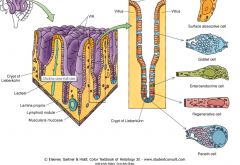
(1) Small and large bowel.
(2) Skin (basal layer stem cells) (3) Marrow |
|
|
The marker of hematopoietic stem cells is ____?
|
CD34+
|
|

What is the stem cell of the lung?
|
Type II pneumocyte
|
|
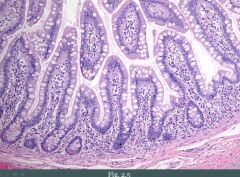
Where would regenerative cells be located on this histograph?
|

|
|
|
Give two examples of a stable tissue.
|
(1) Liver. If you resect the liver, it can regenerate by compensatory hyperplasia. Each hepatocyte can reenter cell cycle and divide and produce additional cells.
(2) Proximal renal tubule. In ATN, cells die, but they can regenerate. |
|
|
How would permanent tissues heal?
|
By repair, not regeneration.
|
|
|
Repair replaces damaged tissues with a ______.
|
scar
|
|
|
When does repair occur?
|
(1) When regenerative stem cells are lost.
(2) When tissue lacks regenerative capacity. |
|
|
The initial phase of repair is called?
|
Granulation tissue. |
|
|
Granulation tissue consists of what? What do each of them do?
|
(1) Fibroblasts (deposit type III collagen)
(2) Capillaries (nutrients) (3) Myofibroblasts (contract wound) |
|
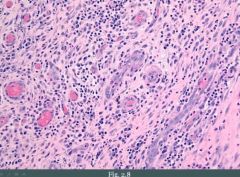
What do you see?
|
Granulation tissue.
|
|
|
Eventually, granulation tissue will produce a __________.
|
scar
|
|
|
In scar formation, what change in collagen happens? What enzyme performs this?
|
Type III collagen is replaced with type I collagen
Collagenase |
|
|
Collagenase requires _______ as a cofactor.
|
zink
|
|
|
Type I collagen is abundant in ________?
|
Bone (bONE = ONE = I)
|
|
|
Type II collagen is primarily seen in ________?
|
Cartilage (CarTWOlage = TWO = II)
|
|
|
Type III collagen is a very __________ (strong/pliable) type of collagen. Where do we see type III collagen?
|
pliable
Blood vessels/lymphatics (need for stretch), granulation tissue (it needs to be able to stretch and mold into a final scar), embryonic tissue (baby is growing and needs to be able to stretch) |
|
|
Type IV collagen is seen where?
|
Basement membrane
|
|
|
What is the mechanism of regeneration and repair?
|
It is mediated by paracrine signaling via growth factors. Interaction of GFs with receptors result in gene expression and cellular growth.
|
|
|
TGF-alpha is an important ___________ and _____________ growth factor.
|
epithelial; fibroblast growth factor
|
|
|
TGF-beta is an important ________________ and it inhibits _________.
|
fibroblast growth factor; inflammation
|
|
|
PDGF is an important ________, _________ and ____________ growth factor.
|
endothelium; smooth muscle; fibroblast
PLTs release it to aid in healing when there is damage. |
|
|
Fibroblast growth factor is a strong ____________ factor and is important for _________ development.
|
angiogenetic; skeletal
|
|
|
Vascular endothelial growth factor is important for ___________.
|
angiogenesis
|
|
|
Cutaneous healing can occur via one of two ways. What are they?
|
(1) Primary intention. You get a wound, brought into the ER and wound edges are brought together. Results in minimal scar formation.
(2) Secondary intention. We don't let the edges be approximated. Tissue remains open and the granulation tissue fills in the defect. |
|
|
Delayed wound healing can be caused by [...]
|
(1) Infection (MCC). Continued inflammation impairs healing.
(2) Vitamin C deficiency (hydroxylation; proline and lysine residues of procollagen must be cross-linked) (3) Copper deficiency (lysyl oxidase) (4) Zinc (collagenase) (5) Other: Foreign body (chronic inflammation), ischemia (no nutrients), diabetes, malnutrition. |
|
|
The normal amino acid structure of collagen is?
|
-Gly-X-Y-
X = proline or lysine (usually proline) Y = proline or lysine (gets hydroxylated)... Vitamin C is needed to -OH the Y amino acids. |
|
|
What is dehiscence? It is most commonly seen after __________ surgery.
|
When the wound opens/ruptures.
Abdominal surgery. |
|
|
What is a hypertrophic scar?
|
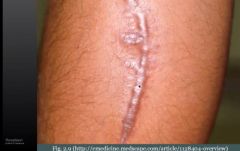
Aberrant healing process: Excess production of scar tissue that is localized to the wound (type I collagen)
|
|
|
What is a keloid?
|
Aberrant healing process: Excess production of scar tissue that is waaay out of proportion to the wound.
|
|
|
A keloid is characterized by excess ____________?
|
type III collagen
|
|
|
There is a genetic predisposition to keloids and it is MC seen in ____________.
|
african-americans
|
|
|
The classic location of a keloid is in the _________.
|
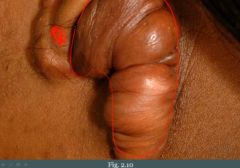
earlobe
Also face and upper extremities. |

